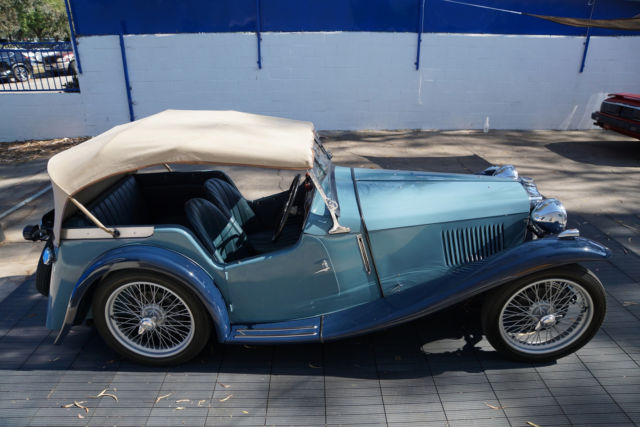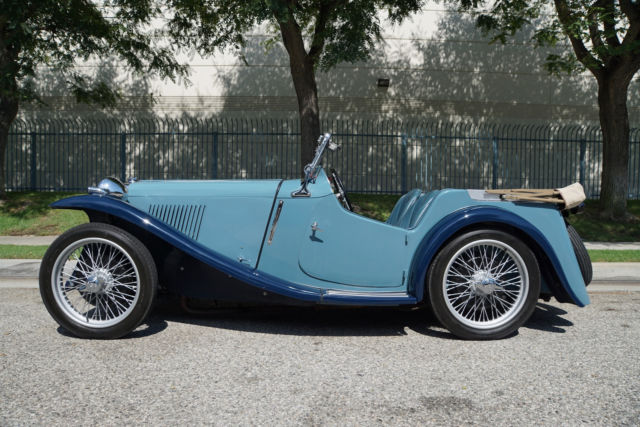1934 MG PA for sale!
Technical specifications of MG PA 1934
| Price: | - |
|---|---|
| Condition: | Used |
| Item location: | Torrance, California, United States |
| Make: | MG |
| Model: | PA |
| SubModel: | -- |
| Type: | Convertible |
| Trim: | -- |
| Year: | 1934 |
| Mileage: | 0 |
| VIN: | PA1438 |
| Color: | Blue |
| Engine size: | 847 cc 4 cylinder |
| Power options: | -- |
| Fuel: | Gasoline |
| Transmission: | Manual |
| Drive type: | -- |
| Interior color: | Blue |
| Options: | -- |
| Vehicle Title: | Clear |
| You are interested? | Contact the seller! |
Description
West Coast Classics are proud to present an absolutely exceptional example of this extraordinarily rare 1934 MG PA Roadster with it's original mathcing #'s 847cc 4 cylinder engine, original 4 speed non-synchromesh transmission, and beautifully presented in it's original correct factory 'Oxford Blue over Cambridge Blue' color paint with all body panels obviously removed, stripped and media blasted prior to re-painting, original chrome and light lenses and grille and a gorgeous correct matching b...lue interior!The car has absolutely no rust and there are no signs or history of any accidents or rust - one very rare example and one of reportedly less than 150 left remaining from a total production build of only 1,973! The car has it's seemingly original tan canvas convertible top and frame with no rips or tears and which is perfectly functional and the car will be sold with it's original tonneau cover (boot), original 'Banjo style' steering wheel, factory spare wheel mounted on the rear, original 'Jaeger' gauges and soon to be banned in 1935 American Sequoia redwood veneer. All the options are working as they should including all the gauges and lights.
The car has been garaged and not run regularly in recent years, the engine starts and the car runs and drives and shifts gear well enough but please note that the car will be needing some engine work to perform correctly as it seems that the compression is weak on one of the cylinders. We have decided to sell the car as is without starting the work ourselves.
The P type Midget was launched in March 1934 as the replacement for the J2 and was produced from (about) March 1934 until the late summer of 1935. 1,973 cars of this type were built and it is reported that no more than 150 MG PA sports cars remain in existence today!It featured an improved overhead camshaft, crossflow 847 cc 4-cylinder engine with twin SU carburetors producing 36 horsepower and it rode on an 87-inch wheelbase chassis with a 4-speed non-synchromesh transmission. However, most of the improvements were in styling and creature comforts. The interior was widened and the instrument panel was in burled sequoia. Trafficators (British for turn signals) and a central lubrication system were included. It is well recognised that the P type had similarities with previous Magnas and Magnettes and its parentage derived from the M and J types. 'Autocar' magazine road tested the P type in November of that year and reported 'This latest model is a marked improvement in all respects over its forerunners'. Sales literature produced by Abingdon claimed, 'In all there are over one hundred new and improved features'. With good reports in the motoring press it was no surprise that the car sold well, with serious production starting at the end of January 1934; over two hundred cars a month were coming off the production lines.
Many MG and pre-war classic sports car enthusiasts consider the MG P- type the purest expression of classic MG styling and the MG PA model is now considered by many to be the quintessential pre-war Midget. When introduced in early 1934, its most important new feature was a three-main- bearing crankshaft. Compared to the previous (two-main-bearing) MG 4-cylinder engines, the P type was fitted with an all new 847cc engine, with three main bearings supporting the rigid crankshaft. This allowed higher engine revolutions to be employed with safety. An improved Tecalemit oil lubrication and filtering system was a welcome addition to the engine. This system had two filters, one externally and the other was a gauze mesh in the sump, both of which ensured thorough filtering of the oil, thus prolonging the life of the crankshaft and cylinder bores. A "smooth flow" cylinder head with inlet ports on one side and exhaust on the other had an overhead camshaft and the new engines were much more robust and also much smoother running.
The transmission was strengthened and improved to withstand the increased engine power output and stresses imposed by competition work and a new design heavy duty clutch was employed to cater for the rigorous stops and starts on sprints and hill climbs. A four speed non-synchromesh gearbox with a low ratio first gear for competition purposes transferred the power to a specially strengthened back axle with a four star differential. Twelve inch diameter brake drums replaced the previously used eight inch variety. This move gave far greater braking efficiency. Hartford friction dampers were fitted to the front of the car and transversally mounted hydraulic spring compensated shock absorbers at the rear gave good suspension and a comfortable ride over most surfaces.
There were other changes too: longer wheelbase, enlarged cockpit, greatly enlarged brake drums. Styling was refined too with the level of standard equipment described in the sales brochure of the time indicated that it was "all the usual equipment that sportsmen demand - supplemented by the following new extras: Easily accessible tool accommodation; non-reflecting fascia board; new revolution counter; chromium plated long range headlamps; new seat adjustment; dual arm electric windscreen wiper; stop and tail lamp; improved hood and side curtains; and new fold flat windscreen with toughened non-discolourable Triplex safety glass."
The first cars produced were all two seaters and following its predecessor the J2 had its wheels painted to match the car's interior, this was soon dropped in favor of aluminum paint. P types were available in three distinctive duo-tone paint schemes, each one came with matching upholstery. Our feature car is painted in Oxford Blue and Cambridge Blue, other options were: Ulster Green and Dublin Green and Carmine Red and Saratoga Red. The most popular single color scheme however was Black, closely followed by Green and then Red followed by Blue. Some cars were produced in primer only to allow the prospective owner to have the car painted to his choice and for an extra ten guineas the owner could specify the factory to complete the car in any color leather or bodywork he so desired.
Most of the design knowledge gained from previous involvement in production car trials and racing proved invaluable to the production of the P type. The chassis was far sturdier than the J type and the body was less angular and had more flowing lines. Two variations were available with either a two or four seater version c












